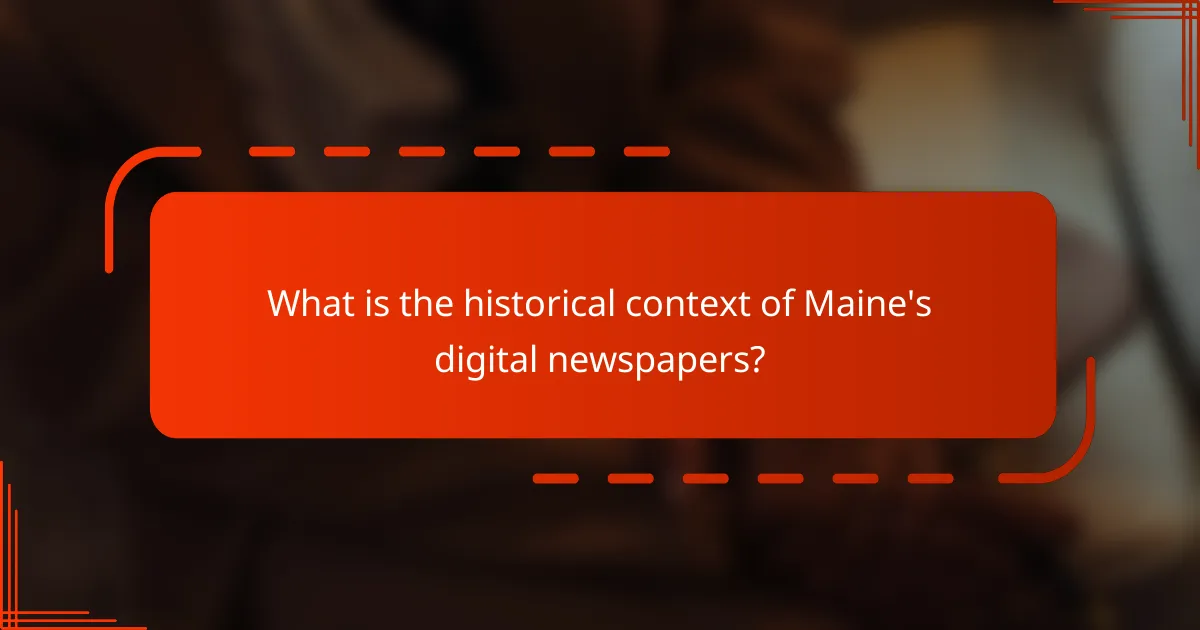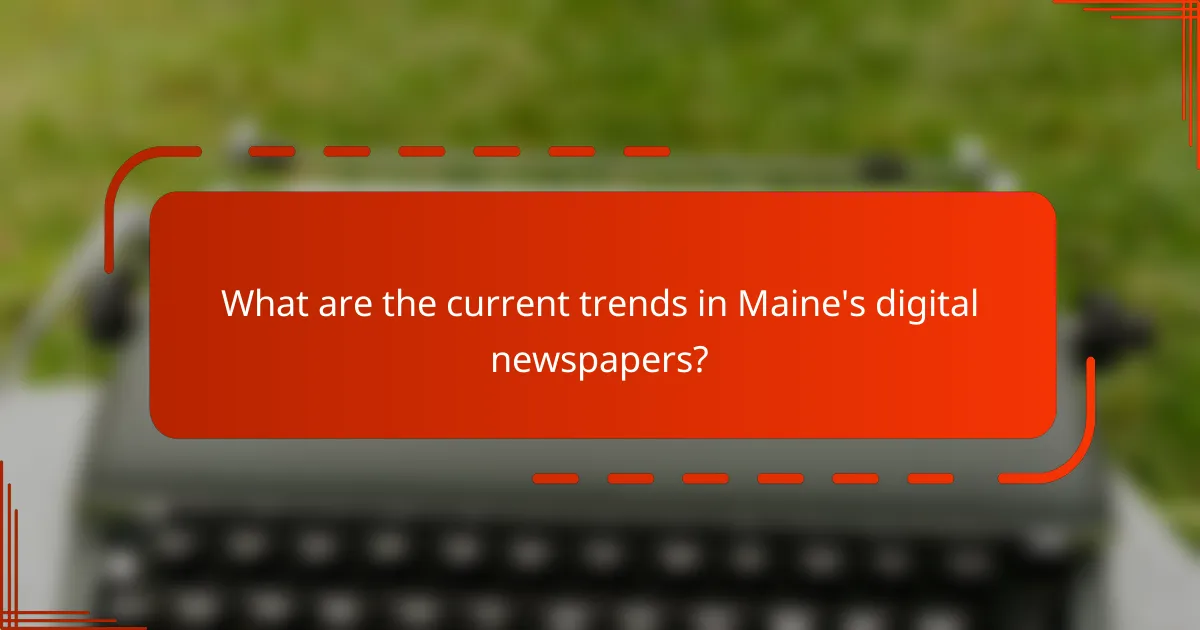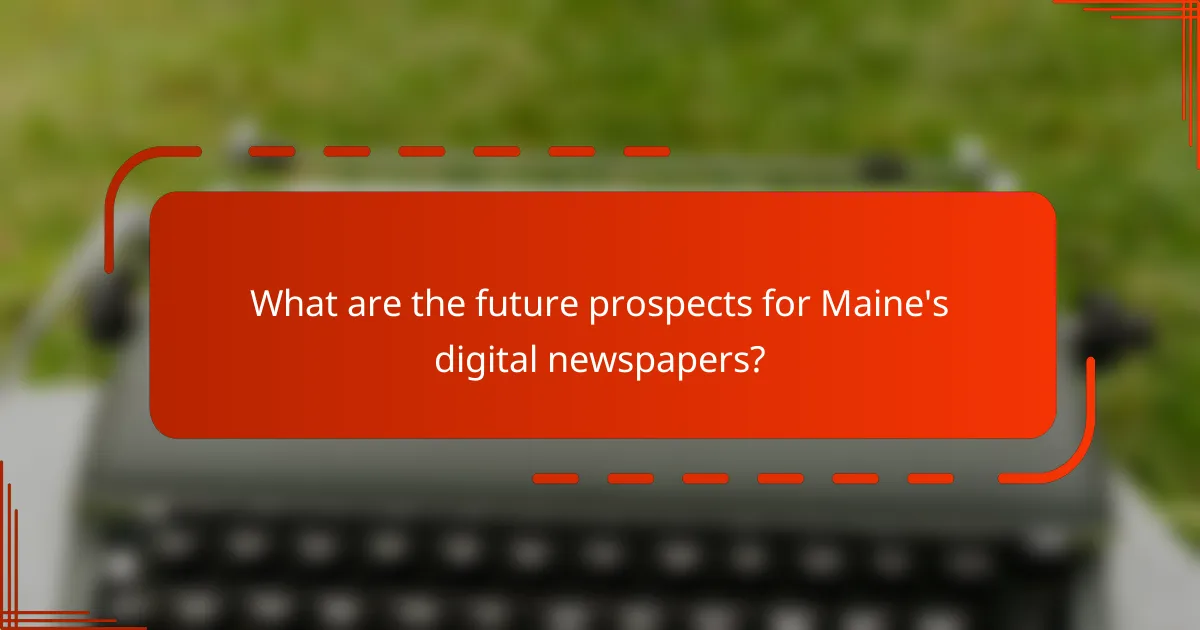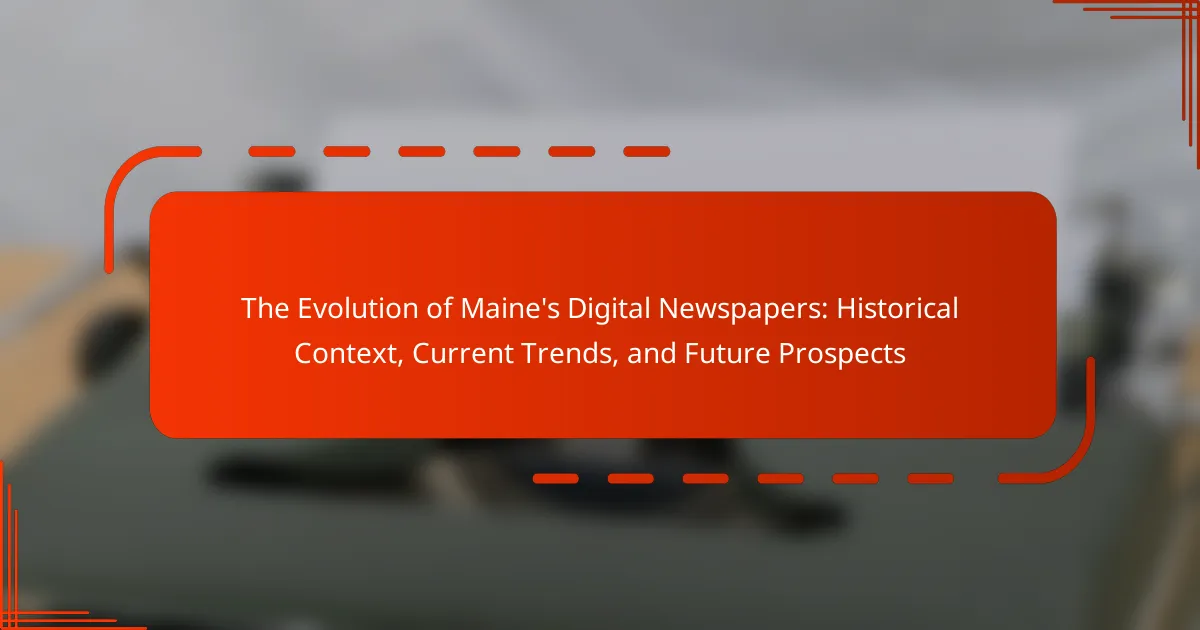Maine’s digital newspapers represent a significant evolution from traditional print formats, beginning in the late 1990s due to technological advancements and increased internet access. Early digital editions allowed local publications to reach wider audiences and provide immediate news updates. The Maine Digital Newspaper Project, initiated in 2007, further enhanced access to historical records, preserving Maine’s local history. Current trends indicate a shift towards multimedia content, social media engagement, and subscription models, reflecting the changing landscape of digital journalism. As internet access and smartphone usage continue to rise, Maine’s digital newspapers are expected to adapt and thrive, focusing on local news coverage and innovative storytelling methods.

What is the historical context of Maine’s digital newspapers?
Maine’s digital newspapers emerged in the late 1990s, transitioning from traditional print formats. The shift was driven by advancements in technology and internet accessibility. Early adopters included local newspapers that recognized the need to reach broader audiences online. By the early 2000s, several Maine publications had established digital editions. This allowed for immediate news updates and broader distribution. The Maine Digital Newspaper Project, launched in 2007, aimed to preserve historical newspapers in digital format. This initiative enhanced access to Maine’s historical records. Today, digital newspapers play a crucial role in informing the public and preserving local history.
How did traditional newspapers evolve into digital formats in Maine?
Traditional newspapers in Maine evolved into digital formats through a gradual process influenced by technological advancements. The rise of the internet in the 1990s prompted many newspapers to establish online presences. By the early 2000s, major publications began offering digital editions alongside print versions.
This transition was driven by changing consumer preferences for immediate access to news. In Maine, local newspapers like the Portland Press Herald launched websites to reach wider audiences. Many newspapers adopted paywalls to monetize their digital content, reflecting trends seen nationally.
As mobile technology advanced, newspapers optimized their websites for smartphones and tablets. Social media platforms also became essential for distributing news. Today, digital formats dominate, with many traditional newspapers relying on online subscriptions and advertising revenue.
The evolution of traditional newspapers into digital formats in Maine is marked by adaptation to technology and shifts in reader behavior.
What technological advancements influenced this transition?
The transition to digital newspapers in Maine was influenced by advancements in internet technology. The rise of high-speed broadband enabled faster access to online content. Mobile technology allowed users to access news on smartphones and tablets. Content management systems simplified the process of publishing digital articles. Social media platforms facilitated news distribution and audience engagement. Analytics tools provided insights into reader preferences and behavior. These advancements collectively transformed how newspapers operate and reach their audiences.
How did consumer behavior change alongside this evolution?
Consumer behavior changed significantly with the evolution of Maine’s digital newspapers. Readers shifted from print to online platforms for news consumption. This transition was driven by the convenience and immediacy of digital access. Data from the Pew Research Center shows that digital news consumption increased by over 20% from 2010 to 2020. Additionally, consumers began to favor multimedia content, such as videos and interactive graphics, over traditional text-based articles. Social media also became a primary source for news sharing, altering how consumers engage with content. The rise of mobile devices further accelerated this change, allowing news access anytime and anywhere. As a result, traditional advertising models were disrupted, leading to a greater emphasis on digital subscriptions and targeted advertising strategies.
What role did local events play in shaping digital newspapers in Maine?
Local events significantly influenced the development of digital newspapers in Maine. They provided timely content that attracted local readership. Events such as town meetings, festivals, and sports games became focal points for news coverage. Digital newspapers adapted by offering real-time updates and multimedia content related to these events. This engagement helped to build community trust and loyalty among readers. As a result, local events shaped the editorial priorities of digital newspapers. They also encouraged the integration of social media for broader outreach. This dynamic interaction with local happenings has been essential for the sustainability of digital journalism in Maine.
Which significant events marked pivotal changes in Maine’s newspaper industry?
The significant events that marked pivotal changes in Maine’s newspaper industry include the establishment of the first newspaper in 1785. This was the “Falmouth Gazette,” which set the foundation for journalism in the state. The introduction of the telegraph in the mid-19th century revolutionized news reporting. It allowed for faster news dissemination across Maine and beyond. The advent of the internet in the late 20th century drastically changed the landscape. Many traditional newspapers began to transition to digital formats. This shift led to the decline of print circulation and advertising revenues. The consolidation of newspaper ownership also occurred during this period. Larger media companies acquired smaller local papers, impacting local journalism. These events collectively shaped the current state of Maine’s newspaper industry.
How did the rise of the internet impact local journalism?
The rise of the internet significantly transformed local journalism. Local news outlets faced increased competition from online platforms. This competition led to reduced advertising revenue for traditional newspapers. Many local newspapers struggled to adapt to the digital landscape. As a result, numerous publications closed or downsized. The internet enabled new forms of journalism, such as citizen journalism and blogs. These platforms provided alternative news sources for local communities. In Maine, the digital shift changed how residents accessed news. Local journalism adapted by developing online content and engaging audiences through social media.

What are the current trends in Maine’s digital newspapers?
Current trends in Maine’s digital newspapers include a shift towards multimedia content and increased engagement on social media platforms. Many digital newspapers are enhancing their storytelling with videos and podcasts. There is also a growing focus on local news coverage to cater to community interests. Subscription models are gaining popularity as revenue sources, with some outlets implementing paywalls. Data journalism is becoming more prevalent, providing in-depth analysis of local issues. Additionally, mobile optimization is crucial as readership increasingly shifts to smartphones. These trends reflect the evolving landscape of digital journalism in Maine.
How are digital newspapers adapting to the changing media landscape?
Digital newspapers are adapting to the changing media landscape by embracing multimedia content and interactive features. They are integrating videos, podcasts, and infographics to enhance storytelling. Subscription models are being adopted to generate revenue as advertising declines. Many digital newspapers are also utilizing social media platforms for wider reach and engagement. Data analytics are being employed to understand reader preferences and tailor content accordingly. Mobile optimization is crucial as more users access news via smartphones. Collaboration with tech companies is increasing to improve user experience and delivery methods. These adaptations are essential for survival in a competitive digital environment.
What new technologies are being adopted by Maine’s digital newspapers?
Maine’s digital newspapers are adopting several new technologies. These include mobile optimization for better accessibility on smartphones. They are also integrating artificial intelligence for personalized content delivery. Additionally, many are utilizing data analytics to understand reader preferences. Some newspapers are exploring augmented reality to enhance storytelling. Blockchain technology is being considered for secure transactions and content verification. These advancements reflect a commitment to modernizing the news experience.
How are content strategies evolving to engage readers?
Content strategies are evolving to engage readers by incorporating multimedia elements and personalized experiences. Digital newspapers in Maine are increasingly using videos, podcasts, and interactive graphics to enhance storytelling. These strategies cater to diverse audience preferences and improve information retention. Additionally, leveraging data analytics allows publishers to tailor content based on reader behavior. For instance, targeted articles and recommendations keep readers engaged longer. Social media integration further promotes content sharing and community interaction. Research indicates that 70% of readers prefer articles with visual content, highlighting the effectiveness of these evolving strategies.
What challenges do Maine’s digital newspapers face today?
Maine’s digital newspapers face significant challenges today. These challenges include declining advertising revenue, which impacts financial sustainability. Additionally, competition from social media platforms diverts audience attention. The shift towards digital consumption requires ongoing investment in technology. Moreover, maintaining journalistic quality amid budget constraints is a pressing concern. Lastly, engaging younger audiences who prefer alternative media sources poses a challenge for traditional digital newspapers.
How does competition with social media affect readership?
Competition with social media significantly reduces readership for traditional news outlets. Social media platforms provide instant news updates, attracting audiences seeking quick information. A study by the Pew Research Center found that 62% of Americans get news from social media. This shift in consumption patterns leads to decreased engagement with traditional digital newspapers. Readers often prefer the interactive and visual content available on social media. Consequently, traditional newspapers face challenges in capturing audience attention. The decline in readership impacts advertising revenue and overall sustainability of these publications.
What financial models are being explored by digital newspapers?
Digital newspapers are exploring several financial models. Subscription-based models are increasingly popular. These models charge readers for access to content. Advertising revenue remains a significant source of income. Some digital newspapers utilize a combination of subscriptions and ads. Sponsored content is also being integrated into their financial strategies. Crowdfunding is emerging as a viable option for some outlets. Nonprofit models are being adopted by others to sustain journalism. These models reflect the changing landscape of media funding.

What are the future prospects for Maine’s digital newspapers?
Maine’s digital newspapers are likely to see growth and adaptation in the coming years. Increased internet access and smartphone usage will drive readership. Local news demand remains strong, with communities valuing relevant content. Digital platforms allow for innovative storytelling and multimedia engagement. Subscription models are emerging as a viable revenue source. Advertisers are shifting focus to digital formats, enhancing financial sustainability. Data from the Pew Research Center indicates a rise in online news consumption. Maine’s unique local culture will continue to shape content strategies.
How might technological advancements shape the future of digital journalism in Maine?
Technological advancements will significantly shape the future of digital journalism in Maine. Enhanced data analytics tools will enable journalists to tailor content to audience preferences. Artificial intelligence can automate news gathering and reporting, increasing efficiency. Virtual and augmented reality may provide immersive storytelling experiences. Mobile technology will allow journalists to deliver news in real-time from anywhere. Social media platforms will continue to be vital for news distribution and audience engagement. These changes can lead to a more informed public and foster community connections. As of 2023, Maine’s news organizations are already exploring these technologies to adapt to evolving consumer habits.
What emerging technologies could redefine news consumption?
Artificial intelligence and machine learning are emerging technologies that could redefine news consumption. These technologies enable personalized news delivery based on user preferences. AI algorithms analyze reader behavior to curate relevant content. Additionally, augmented reality (AR) and virtual reality (VR) offer immersive news experiences. They allow users to engage with news stories in a more interactive manner. Blockchain technology enhances transparency in news distribution. It can verify the authenticity of news sources. Furthermore, voice-activated devices are changing how news is accessed. Users can receive updates through smart speakers and assistants. Collectively, these technologies are transforming the landscape of news consumption.
How might audience engagement strategies evolve in the coming years?
Audience engagement strategies are likely to evolve towards more personalized and interactive experiences. Advances in data analytics will enable publishers to tailor content to individual preferences. This will enhance user satisfaction and retention. Additionally, the use of artificial intelligence will facilitate real-time audience feedback. Publishers may implement chatbots and live interactions to foster community engagement. Video content and live streaming are expected to become more prevalent. These formats can increase viewer participation and emotional connection. Research indicates that interactive content can boost engagement rates significantly. For example, a study by HubSpot found that interactive content generates twice the engagement of static content.
What strategies can Maine’s digital newspapers implement for sustainability?
Maine’s digital newspapers can implement subscription models to enhance sustainability. This strategy allows for a steady revenue stream. Research indicates that digital subscriptions can increase profitability. For instance, The New York Times reported over 10 million digital subscribers in 2021. Additionally, diversifying revenue through local advertising can support financial stability. Community engagement initiatives can also foster loyalty and increase readership. Collaborating with local businesses for sponsorship can enhance visibility and support. Emphasizing quality journalism can attract and retain subscribers. Lastly, leveraging social media for audience growth can further enhance sustainability.
How can collaboration among local news outlets enhance their viability?
Collaboration among local news outlets can enhance their viability by pooling resources and sharing content. This approach reduces operational costs and increases coverage quality. By working together, news outlets can reach wider audiences. They can also share investigative resources, leading to more in-depth reporting. Collaboration fosters innovation through shared ideas and technology. According to a study by the Pew Research Center, collaborative journalism initiatives have shown increased audience engagement. Additionally, partnerships can help local outlets compete against larger media corporations. This collective effort strengthens the overall news ecosystem in the community.
What role does community involvement play in the future of digital newspapers?
Community involvement is crucial for the future of digital newspapers. It fosters a sense of ownership and accountability among readers. Engaged communities are more likely to support local journalism financially. Research shows that newspapers with strong community ties see higher subscription rates. Local news content tailored to community interests increases reader engagement. Digital platforms enable direct feedback and interaction between newspapers and their audiences. This feedback loop enhances content relevance and quality. As a result, community involvement can drive the sustainability of digital newspapers in an evolving media landscape.
What practical steps can readers take to support Maine’s digital newspapers?
Readers can support Maine’s digital newspapers by subscribing to their services. Subscriptions provide essential revenue for these publications. Engaging with their content through comments and social media shares boosts visibility. Donations to nonprofit digital newspapers can also enhance their sustainability. Attending local events hosted by these newspapers fosters community support. Readers should encourage others to subscribe and share articles to widen the audience. Supporting advertising partnerships can help local businesses and newspapers alike. Promoting media literacy ensures a well-informed readership that values quality journalism.
The main entity of the article is Maine’s digital newspapers, which have evolved significantly from traditional print formats since the late 1990s due to technological advancements and changing consumer behaviors. The article outlines the historical context of this evolution, including the establishment of the Maine Digital Newspaper Project and the impact of local events on digital journalism. It further discusses current trends such as multimedia content, subscription models, and the challenges faced by digital newspapers, including competition from social media and declining advertising revenue. Finally, the article explores future prospects and emerging technologies that could shape the landscape of digital journalism in Maine.
